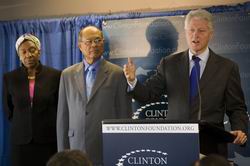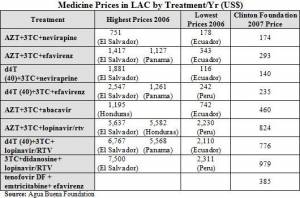« Assessing the Lamberts Windfarm Proposal | Home | Improving Environmental Governance in Uruguay »
Cheaper HIV/AIDS Treatments for LAC Nations
By Keith R | June 7, 2007
Topics: Health Issues, Pharmaceutical Issues | No Comments »
 In May former US President Bill Clinton announced that his foundation had negotiated new agreements to substantially reduce the price of 15 so-called “second-line treatments” for HIV/AIDS, plus a new, “next generation” once-a-day pill, for 66 poor and middle-income countries. The 66 (chosen because they represent about 90% of the world’s AIDS cases) includes many Latin American and Caribbean (LAC) nations; in fact, LAC is the second largest regional grouping covered by the plan. For a list of which LAC nations are covered, see the list at the end of this post.
In May former US President Bill Clinton announced that his foundation had negotiated new agreements to substantially reduce the price of 15 so-called “second-line treatments” for HIV/AIDS, plus a new, “next generation” once-a-day pill, for 66 poor and middle-income countries. The 66 (chosen because they represent about 90% of the world’s AIDS cases) includes many Latin American and Caribbean (LAC) nations; in fact, LAC is the second largest regional grouping covered by the plan. For a list of which LAC nations are covered, see the list at the end of this post.
“Second-line treatments” are those doctors prescribe for AIDS patients that are developing resistance to the most commonly prescribed (“first-line”) therapies. In markets without pharmaceutical price controls, the prices for second-line treatments can be as much as 10 times more than first-line therapies, putting them beyond the meager AIDS budgets of most developing countries and in many cases forcing national health officials to stop giving patients treatment once they develop resistance to first-line therapies. It is estimated that by 2010 nearly half a million HIV/AIDS patients will require second-line ARVs.
 The Clinton Role
The Clinton Role
The Clinton Foundation is not new to this. Its HIV/AID Initiative (CHAI) was launched by Clinton in 2002, and over the last four years it has negotiated with pharmaceutical companies six rounds of price reductions for high-quality AIDS-related anti-retroviral drugs (“ARVs”) and diagnostics.
CHAI also works in securing procurement for participating nations with UNITAID. UNITAID is the international purchasing facility for HIV/AIDS, tuberculosis (TB) and malaria treatments started jointly in 2006 by the governments of France, Brazil, Chile, Norway and the UK, with support from the World Health Organization (WHO), UNAIDS, UNICEF, the Global Fund to Fight AIDS, TB and Malaria (GFATM), and the Bill and Melinda Gates Foundation. Currently some 34 nations have either joined or committed to join as UNITAID donors. UNITAID’s work is funded by small levy on airline tickets.
Presently some 750,000 people receive ARVs purchased under CHAI agreements.
Arriving at the Deal
CHAI explains this far better than I could ever rephrase, so I will quote them directly:
In partnership with UNITAID, CHAI issued an open invitation in March to 15 manufacturers for proposals to supply second-line drugs this year. Cipla and Matrix, a division of Mylan Laboratories, agreed to price their drugs on a “cost-plus” basis and collaborated with CHAI to lower production costs, in part by securing lower prices for key raw materials and by addressing major chemistry challenges. CHAI has agreed to use UNITAID funds to purchase these reduced-priced medicines, guaranteeing purchase volumes. Additional suppliers selected to participate in the program for 2007 include Abbott, Aurobindo, Bristol Myers Squibb, Gilead Sciences, Ranbaxy, and Aspen Pharmacare and IDS Group, as designated distributors of Gilead in Africa and Asia. CHAI will facilitate a similar process of competitive bidding and supplier selection for the 2008 portion of the program, and expects to announce further price reductions by the end of the year.
The ARVs included in CHAI’s pricing agreements are: abacavir (ABC), didanosine (DDI), efavirenz (EFV), emtricitabine (FTC), lamivudine (3TC), lopinavir/ritonavir (LPV/r), nevirapine (NVP), stavudine (d4T), tenofovir (TDF) and zidovudine (AZT). Many of those included in the accords are generic versions of patented drugs.
Are the Cuts Significant and For Real?
Clinton and CHAI claim that these agreements will cut the price of ARVs by about 25% for poor countries (many of whom are already beneficiaries of special price discounts offered by companies or negotiated by third parties) and 50% for middle-income countries.
 Just how significant might these cuts be for HIV/AIDS patients and public health budgets in the LAC nations included in the program? For an idea of how significant, I consulted the website of the Agua Buena Foundation in Costa Rica, an NGO that has been tracking ARV prices and availability and campaigning for price cuts and greater ARV access for years. The table at right (click to enlarge) provided by Agua Buena demonstrates that in most cases the savings will be very significant.
Just how significant might these cuts be for HIV/AIDS patients and public health budgets in the LAC nations included in the program? For an idea of how significant, I consulted the website of the Agua Buena Foundation in Costa Rica, an NGO that has been tracking ARV prices and availability and campaigning for price cuts and greater ARV access for years. The table at right (click to enlarge) provided by Agua Buena demonstrates that in most cases the savings will be very significant.
I like how Agua Buena puts this in perspective on very human terms:
Estos nuevos precios permitirán brindar tratamiento a más personas en los países de la Región que tienen convenio con la Fundación. Si tomamos como ejemplo la combinación de AZT+3TC+Lop/rtv, esquema de uso común cuando hay evidencia de resistencia a los medicamentos de primera línea; El Salvador podrá proveer este tratamiento a 6 personas con el mismo dinero que utilizaba para el tratamiento de una persona el año pasado. Lo mismo en Honduras.
La posibilidad de extensión de tratamiento será mayor si estimamos que con el ahorro que se tendrá por la compra de un tratamiento de segunda línea se podrá brindar tratamiento a 26 PVVS con el primer esquema de la lista (azt+3tc+nvp), a 15 con el segundo esquema (azt+3tc+efv) y hasta a 33 PVVS si se opta por el tercer esquema (d4t+3tc+nvp).
Si las proporciones se mantienen, con el mismo dinero utilizado en compras de medicamentos en el año 2006, será posible incrementar entre 30% y 60% la provisión de tratamiento en el 2007 y 2008.
[Rough translation: These new prices will permit the provision of treatment to more people in the countries in the Region that have agreements with the Foundation. If we take the example of AZT+3TC+Lop/RTV, the regime usually sued when there is evidence of resistance to first-line medicines, El Salvador could provide this treatment to six persons with the same money used to treat one last year. The same is true of Honduras.
The possibility of extending treatment would be better if we estimate that with the savings that we could have for the purchase of second-line treatments we can provide treatment to 26 people living with HIV/AIDS (PVVS) with the first regimen on the list (AZT+3TC+nvp), to 15 with the second regimen (AZT+3TC+efv) and up to 33 PVVS if we opt for the third regimen.]
If these proportions are maintained, with the same money utilized in the purchase of medicines that was used in 2006, it would be possible to increase between 30% and 60% treatment provision in 2007 and 2008.
But will patients “on the ground” in LAC see those cuts in full? In the past there have been several announced discounts — including those negotiated by the Pan American Health Organization (PAHO) or by groups of nations with PAHO help — which did not translate into actual significant reductions to the end-user in most LAC nations. The reasons for this vary; for example, some distributors in the region did not honor in full the pledges made by manufacturers. In some cases, the drugs in question were not registered for authorization for placement on the national market (registro sanitario).
By most accounts, so far the Clinton Foundation’s track record in seeing that promised cuts materialize in the end markets has been pretty good. It probably doesn’t hurt to have the persuasive powers of Clinton and purchasing clout of UNITAID behind it.
— Keith R
LAC Nations Covered by the CHAI Deal
Argentina
Bahamas
Barbados
Belize
Brazil
Colombia
Dominican Republic
Ecuador
Guatemala
Guyana
Haiti
Honduras
Jamaica
Organization of Eastern Caribbean States (OECS)*
Peru
Suriname
Trinidad and Tobago
Turks and Caicos
* The OECS has nine member states: Antigua & Barbuda, Dominica, Grenada, Montserrat, St. Kitts & Nevis, St. Lucia, St. Vincent & the Grenadines
Tags: abacavir, Abbott, Agua Buena Foundation, AIDS, Argentina, ARVs, Aspen Pharmacare, Aurobindo, AZT, Bahamas, Barbados, Belize, Bill & Melinda Gates Foundation, Brazil, Bristol Myers Squibb, CHAI, Chile, Cipla, Clinton Foundation, Colombia, d4T, DDI, diagnostics, didanosine, Dominican Republic, Ecuador, efavirenz, emtricitabine, fármacos, first-line therapies, France, Fundación Clinton, generics, GFATM, Gilead Sciences, Guatemala, Guyana, Haiti, Honduras, IDS Group, Jamaica, lamivudine, lopinavir/ritonavir, malaria, Matrix, medicamentos, medicinas, medicines, Mylan Laboratories, nevirapine, Norway, OECS, OMS, patented drugs, Peru, pharmaceuticals, PVVS, Ranbaxy, SIDA, stavudine, Suriname, tenofovir, Trinidad and Tobago, tuberculosis, Turks and Caicos, UK, UNAIDS, UNICEF, UNITAID, WHO, zidovudine


